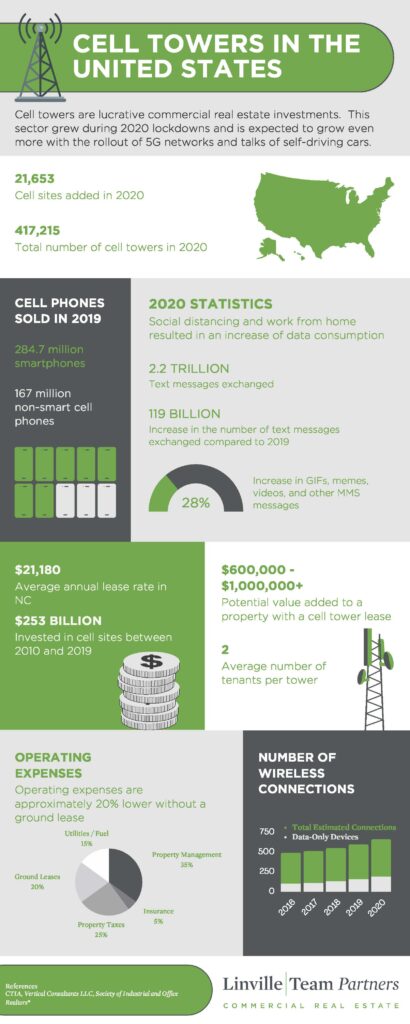Cell towers are not pretty pieces of infrastructure, but their profits are very attractive. This sector has grown since 2020 lockdowns and is expected to grow more with the rollout of 5G networks and self-driving cars. You expect your mobile devices to work wherever you are, so the value of towers and the need for prime real estate keeps growing. This rapid growth potential isn’t found in most real estate investments. Here are 5 reasons to invest in cell towers now:
1. Creditworthy Tenants
Cell tower lease agreements are between a property owner and a cellular provider like Verizon and T-Mobile. The agreement can also be between the property owner and a tower company like Crown Castle and American Tower. The lease gives the cellular provider permission to operate equipment on an existing tower to increase their wireless coverage in exchange for rent. As the owner, you hope to own a tower that has space for multiple tenants.
2. ‘Sticky’ Tenants
Renewal rates are reliable, hovering around 98% and remaining stable through financial turns. Wireless companies will likely incur a coverage gap and significant costs associated with labor and equipment if they vacate a tower. Since bad coverage is the most common reason users switch carriers, the carriers work to maintain their current coverage while expanding into new sites.
3. Minimal Improvements That Increase Profits
Looking towards the future, lease modifications should be made when carriers upgrade 4G network components with 5G-compatible equipment. These modifications typically include an increase in rental rates and term extensions. While there are many advantages for carriers to upgrade their signals, this upgrade from a 4G signal to a very speedy 5G signal results in a shorter range. This shorter range will likely result in a need for even more cell sites as cellular companies move to 5G.
4. Low Operating Expenses
Besides staying on top of evolving technology trends, ongoing maintenance is generally minimal. If the land under the tower is not owned, then a ground lease expense may apply on top of typical operating expenses (taxes, utilities, maintenance, and insurance). Operational maintenance may include keeping FAA-required lighting on the top of the structure running, maintaining fencing, keeping the area under the tower free of debris and vegetation, and maintaining a clear path on any access roads. The tower owner is not responsible for costs associated with adding a new tenant’s equipment.
5. Leverage Existing CRE Investments
Smaller towers are being developed that can be mounted on buildings and billboards to save land space and to more rapidly expand the number of locations for cell towers with the 5G movement underway.
Not All That Glitters Is Gold
Cell towers are a great investment, but there are a few cons to consider. For a landowner, long term lease agreements (25+ years) and property easements may impact the future development potential on the property. Cell towers are not aesthetically pleasing to residents, and some perceive that there may be health risks to living within proximity. As with any investment, there are financial risks to consider. Don’t invest in a tower without an existing or committed tenant. Cell tower demand is currently high, but carrier mergers and acquisitions could change the game. On top of that, evolving technology could result in a solution that displaces the use of cell towers.
Final Words of Advice
Cell phone towers have never been in higher demand, and they’re selling for more than they ever have. With a growing number of devices that are relying on highly sophisticated data streams and more cell sites, cell tower investors are well-positioned to benefit from the world’s increasing consumption of wireless data. If you own a property with a cell tower on it or are interested in purchasing one, reach out to one of our brokers to assist you throughout the process.
- 7 Emerging Industries to Keep Watching in 2025
- The Modern Investor’s Toolkit (Even If Real Estate Isn’t Your Day Job)
- Why Company Culture Matters in Real Estate (and Every Industry)
- Why Leasing Strategy Is More Than Just Signing the Deal
- Cap Rates, Co-Tenancy, and Contingencies: A Real Estate Glossary for Operators
